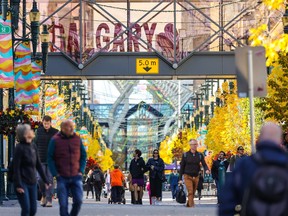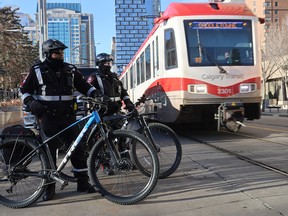Concerns over social disorder and crime in the city’s downtown core and along its LRT lines have mounted in recent years, prompting a range of responses

Article content
The city is earmarking $1.9 million to enhance public safety in the downtown core.
A product of budget deliberations last fall, the one-time funding will target several facilities in the core located near Calgary Transit lines, by bolstering measures such as lighting, additional security staff and the presence of surveillance cameras.
Article content
Concerns over social disorder and crime in the city’s downtown core and along its LRT lines have mounted in recent years, prompting a range of responses that have included provincial funding to add police patrols and task forces working to find solutions.
Advertisement 2
Article content
“Our civic partners provide important programs and services downtown and near transit and contribute to the vibrancy of our downtown. We want to ensure they can focus their resources on providing their essential services,” Lori Kerr, manager of Major Partners said in a statement Tuesday.
“We know with these funds our civic partner spaces will continue to be safe for staff, customers and all Calgarians.”
Recipients of the grants will be the Calgary Public Library, Arts Commons, Contemporary Calgary Arts Society, Fort Calgary Preservation Society, MNP Community Sports Centre, Telus Convention Centre and Vecova Centre for Disability Services and Research.
Said Mayor Jyoti Gondek: “By collaborating with our partners, we are able to address the complex challenges in our downtown with compassion.”
The city is adding 65 transit peace officers to the beat, with 12 of them having graduated late last month, while also improving CCTV and lighting coverage on LRT platforms.
Downtown Safety Leadership Table to release report with 28 recommendations
Starting last fall, the Downtown Safety Leadership Table began four months of meetings with business and community figures to find ways of making the city centre more welcoming.
Article content
Advertisement 3
Article content
On Wednesday, they’ll unveil a resulting report containing 28 recommendations, noted task force co-chair Mark Garner, who called the $1.9-million investment a worthwhile piece of a larger puzzle.
“The positive thing I see is there’s numerous stakeholders getting some money to address the issues they have, especially along the transit lines where we see the majority of the problems,” said Garner, executive director of the Calgary Downtown Association.
Those security enhancements should have some impact on what might appear to be a surprisingly small number of offenders — 50 to 100 that are responsible for 80 to 90 per cent of the problems in the city’s downtown, he said.
Recommended from Editorial
One of the things his report will emphasize is the need for a “state of good repair,” or aesthetic improvements throughout the core “that leads to a perception of safety.”
Advertisement 4
Article content
“We’re going to hold the city’s feet to the fire to ensure they implement all 28 recommendations,” said Garner.
Calgarians surveyed on transit safety, sheriff deployments
A city survey conducted last November showed 72 per cent of Calgarians feel safe using LRT during the day, compared to 67 per cent who said so the previous spring.
But while the results showed some improvements in the perception of safety during the day, a majority of participants said they still don’t feel safe taking the train at night.
Only 39 per cent of respondents said they feel safe riding the CTrain after dark, while 34 per cent said they feel safe waiting for the train after nightfall. Those numbers are improvements from last May, however, when 33 per cent said they felt safe riding the CTrain at night and 27 per cent said they felt safe waiting for the train.
And nearly half of respondents — 49 per cent — said they avoid using Calgary Transit due to safety concerns, up two percentage points from the last survey.

Also, Alberta’s three-month pilot deployment of sheriffs in Calgary’s core received lukewarm reception from the downtown business community last year, says a report on the program.
Advertisement 5
Article content
The five-page Calgary Police Service report, dated Aug. 14, found that despite increased public awareness of the sheriff program, there was not a “marked decrease” in social disorder that would typically be seen during increased enforcement and patrols.
When the 76 downtown businesses and residential agencies surveyed were asked why their perceptions of safety didn’t change, several cited “ongoing open-air drug use, generalized social disorder, and safety on transit.” (Fifty-six per cent of respondents said their perception of safety didn’t change during the pilot, but many said it wasn’t long enough to have an effect and they would welcome future sheriff support.)
‘It can’t be just a one-time expense’
Garner said his task force work shows the need for more transparency of data collected by emergency and social agencies and the urgency in tackling the roots of social disruption.
“There’s social inequities, housing, mental health and addictions and they aren’t going to stop next year — it can’t be just a one-time expense,” he said.
“Something’s got to change because the way we’re doing it now isn’t working.”
But he said since just last year, things are looking up downtown as more people are returning following the pandemic exodus.
“People have said they notice a change, they’re noticing peace officers and bylaw officers on transit,” said Garner.
“We’re starting the year almost back to 2019 (numbers) — people are coming back.”
— With files from Matt Scace and Scott Strasser
Article content





